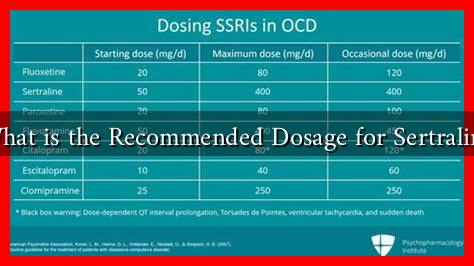-
Table of Contents
What is the Recommended Dosage for Sertraline?
Sertraline, commonly known by its brand name Zoloft, is a selective serotonin reuptake inhibitor (SSRI) widely prescribed for the treatment of various mental health conditions, including depression, anxiety disorders, obsessive-compulsive disorder (OCD), and post-traumatic stress disorder (PTSD). Understanding the recommended dosage for sertraline is crucial for both patients and healthcare providers to ensure effective treatment while minimizing potential side effects.
Understanding Sertraline Dosage
The dosage of sertraline can vary significantly based on individual patient needs, the specific condition being treated, and the patient’s response to the medication. The following factors influence the recommended dosage:
- Age
- Weight
- Severity of the condition
- Presence of other medical conditions
- Concurrent medications
Initial Dosage Recommendations
For adults, the typical starting dose of sertraline is:
- Depression and OCD: 50 mg once daily
- Panic Disorder: 25 mg once daily, increased to 50 mg after one week
- Social Anxiety Disorder: 25 mg once daily, increased to 50 mg after one week
- PTSD: 50 mg once daily
For children and adolescents aged 6 to 17, the initial dosage is generally lower, often starting at:
- OCD: 25 mg once daily for children aged 6-12, and 50 mg for those aged 13-17
- Depression: 50 mg once daily for adolescents aged 13-17
Adjusting the Dosage
After the initial dosage period, healthcare providers may adjust the dosage based on the patient’s response and tolerance. The maximum recommended dose for adults is:
- 200 mg per day
It is essential to note that any dosage adjustments should be made under the guidance of a healthcare professional. For instance, a patient may experience side effects at a lower dose, necessitating a reduction, or they may require an increase if symptoms persist.
Case Studies and Statistics
Research indicates that sertraline is effective for many patients. A study published in the Journal of Clinical Psychiatry found that approximately 60% of patients with major depressive disorder experienced significant improvement with a dosage of 50 mg per day. Furthermore, a meta-analysis revealed that SSRIs, including sertraline, are among the most effective treatments for anxiety disorders, with a response rate of about 50-70% in patients.
Potential Side Effects
While sertraline is generally well-tolerated, it can cause side effects, particularly when starting treatment or adjusting dosages. Common side effects include:
- Nausea
- Diarrhea
- Insomnia
- Sexual dysfunction
- Dry mouth
Patients should report any severe or persistent side effects to their healthcare provider, as they may require a dosage adjustment or a change in medication.
Conclusion
In summary, the recommended dosage for sertraline varies based on individual factors and the specific condition being treated. Starting doses typically range from 25 mg to 50 mg per day, with adjustments made as necessary under medical supervision. Understanding the importance of adhering to prescribed dosages can significantly impact treatment outcomes and overall mental health. As with any medication, open communication with healthcare providers is essential to ensure safe and effective use of sertraline.

